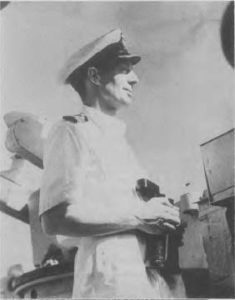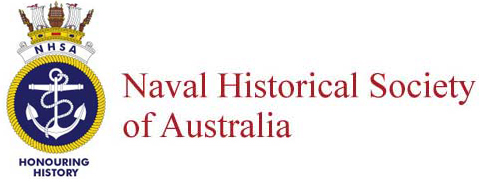- Author
- Newspaper, London Daily Telegraph
- Subjects
- Biographies and personal histories, History - WW2
- Tags
- None noted.
- RAN Ships
- HMAS Sydney II
- Publication
- December 1989 edition of the Naval Historical Review (all rights reserved)

Vice-Admiral Sir John Collins, who has died in Sydney aged 90, was Australia’s most celebrated sailor of the 1939-45 War. His destruction of the Italian cruiser Bartolomeo Colleoni at the Battle of Cape Spada off the north coast of Crete in July 1940 brought pride to his country at a low point in the war. Commanding the cruiser Sydney, Collins opened fire at 19,000 yards and soon scored hits until the Colleoni – on fire and down by the bows – was finished off by two British destroyers. Sydney escaped with a large hole in the funnel.
It was an echo of the 1914-18 War when an earlier HMAS Sydney scored an equally famous victory by destroying the German raider Emden at the Cocos Islands.
The city of Sydney gave Collins and his crew a triumphant welcome and presented them with individual medallions. Soon afterwards, while under another commander, the ship disappeared with all hands in an encounter with the German auxiliary cruiser Kormoran in the Indian Ocean off Western Australia. Both ships were sunk.
The son of a seafaring surgeon, John Augustine Collins was born in Deloraine, Tasmania, on Jan. 7 1899. In 1913, two years after the creation of the Royal Australian Navy, he was one of the initial class of cadets at the Royal Australian Naval College. In 1917 he was appointed to the Grand Fleet at Scapa Flow as a midshipman, and was in a picket boat on the night the battleship Vanguard blew up.
Between the wars Collins distinguished himself at the Royal Naval College, Greenwich. He was naval liaison officer in the battle-cruiser Renown during the visit to Australia of the Duke and Duchess of York (later King George VI and Queen Elizabeth).
Having commanded Sydney, he was sent to Singapore as Assistant Chief of Staff to the C-in-C China. There he experienced the disastrous period from the sinking of the Prince of Wales and the Repulse, to the loss of the Dutch East Indies.
Later, as Captain of HMAS Shropshire, he joined the US 7th Fleet and commanded a task force which included American cruisers and destroyers.
He was a commodore in HMAS Australia when, on Trafalgar Day 1944, a Japanese kamikaze aircraft smashed into the bridge, killing many and severely wounding Collins. But he recovered in time for the Japanese surrender ceremonies in Tokyo Bay.
In 1947 Collins was appointed First Naval Member and Chief of Naval Staff, the first Royal Australian Naval College graduate to reach the top after the Australian Prime Minster, Ben Chifley, had insisted on ending the system in which Australia relied on Royal Navy Admirals on loan. Collins held the post for seven years.
Having retired from the service, he was Australian High Commissioner in New Zealand from 1956 to 1962. In 1965 he was said to have declined the honour of being Governor-General of Australia.
John Collins was a compassionate man. Having finished off the Italian destroyer Espero in the Mediterranean, he risked submarine attack to pick up survivors, and when ordered to leave the scene, left behind a lifeboat. At Batavia, beset by crises, he nevertheless took pains to get a shipload of starving sheep ashore. In 1933 the Royal Humane Society conferred its testimonial for his rescue of a girl swept out to sea off the Cornish coast; though perhaps the braver action came later when, having lost his underpants in the rescue, Collins had to walk the length of the promontory at Portwrinkle.
He played hockey until he was 40, was a useful tennis player and an enthusiastic stream and deep-sea fisherman. In later life he became a skilled bookbinder. His memoirs were entitled: “As Luck Would Have It” (1965).
Collins was appointed CB in 1940 and KBE in 1951. In 1930 he married Phyllis McLachlan, and had a daughter. Vice Admiral Sir John Collins was the first Patron of The Naval Historical Society.
(Source: London Daily Telegraph)
